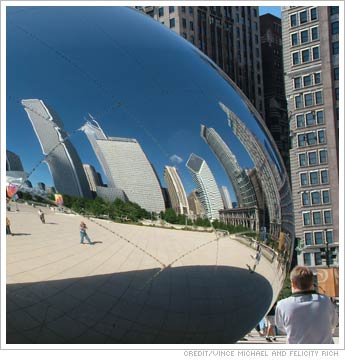By Natasha Julius
I know how it works. As a jaded Chicagoan I’m supposed to reject Millennium Park outright as a symbol of everything that’s wrong with our city. It arrived heinously over-budget and comically overdue, an unmistakable whiff of patronage surrounding its development. The plan to cram four major public art works onto a 24-acre site along with plazas, pavilions, an ice rink, and a state-of-the-art bicycle storage facility has resulted in a sort of cultural Portillo’s; a vast clearinghouse of sensory experiences that, consciously or not, substitutes noise for nuance, capacity for quality, and pandering for populism. So yes, in many ways I can dismiss Millennium Park as a great, gaudy symbol of how this city has lost its way.
Yet there is one feature of the park that cuts through my urban skepticism. Rising like a stainless steel beacon of hope from the AT&T Plaza, Anish Kapoor’s Cloud Gate sculpture is a reminder that sometimes Chicago’s brash ambition and constant urge to cast off and reinvent can create something wonderful. Sure, a lot of times we wind up with a jumbled mess, a garish box or a pointless heap of concrete. But these colossal disappointments are mitigated by the glorious success of the Bean.
I freely admit I was somewhat in love with the Bean before I’d even seen it. I’ve been fascinated by Kapoor’s work since learning he’d unwittingly developed a working Death Star. And I’ll gladly concede the point that the Bean came in even more budget-bloated and behind schedule than the rest of Millennium Park. I don’t care. In my eyes, the Bean is a triumph.

That visitors have swarmed to slap their grubby hands on every reachable inch of its sinuous surface speaks to the Bean’s success. Truly great public art draws in each individual viewer with the promise of a unique experience. In this sense, the Bean is doubly rewarding. It offers two distinct worlds. The concave underside constantly reinterprets the viewer’s own image as he or she moves through the metaphoric gate. It’s an intimate act, watching your form elongate, evaporate and reappear infinitesimal in the arch’s central omphalos (so dubbed by Kapoor with all the subtlety of a kick in the pants). The interior Bean indulges your need to place yourself in your surroundings even as it challenges your notion of what those surroundings are.
But to me it’s the outside of the Bean that offers the greater reward. To say that the polished surface reflects the surrounding buildings is to miss the significance of Kapoor’s achievement. The Bean presents Chicago as a gift to the viewer, creating a wholly new interpretation of a familiar skyline. It isolates a stretch of Michigan Avenue many of us have never stopped to examine before. Crucially, the convex shape of the Bean makes it almost impossible for viewers to locate themselves in the reflection from a distance. This forces them to explore Chicago as a work of art, shifting and developing as they approach. It’s as though the Bean wants us to appreciate the masterpiece that was already there – an enormous, beautiful, disorienting city; a place to get lost in, to discover, and ultimately to admire.
Yes it’s true. Millennium Park is the drunk uncle of Chicago public spaces; kind of sloppy, overflowing with bravado and incoherently shouting half-cooked ideas at anyone it thinks will listen. Sometimes it’s fun to banter with it for a while, but usually it just gives you a headache. Still, every time I think I’ve heard enough out of it, the Bean draws me back in. Its greatness reminds me that those ideas, while nutty, were noble; that the ballsy attitude isn’t just the liquor talking. It makes what would otherwise feel like an eternity of uncomfortable Thanksgiving dinners joyous and invigorating. And for that reason, I love that giant Bean.
See also The Human Bean and the City, and Postcard Pablum: The Failure of Millennium Park.
Posted on July 17, 2006


